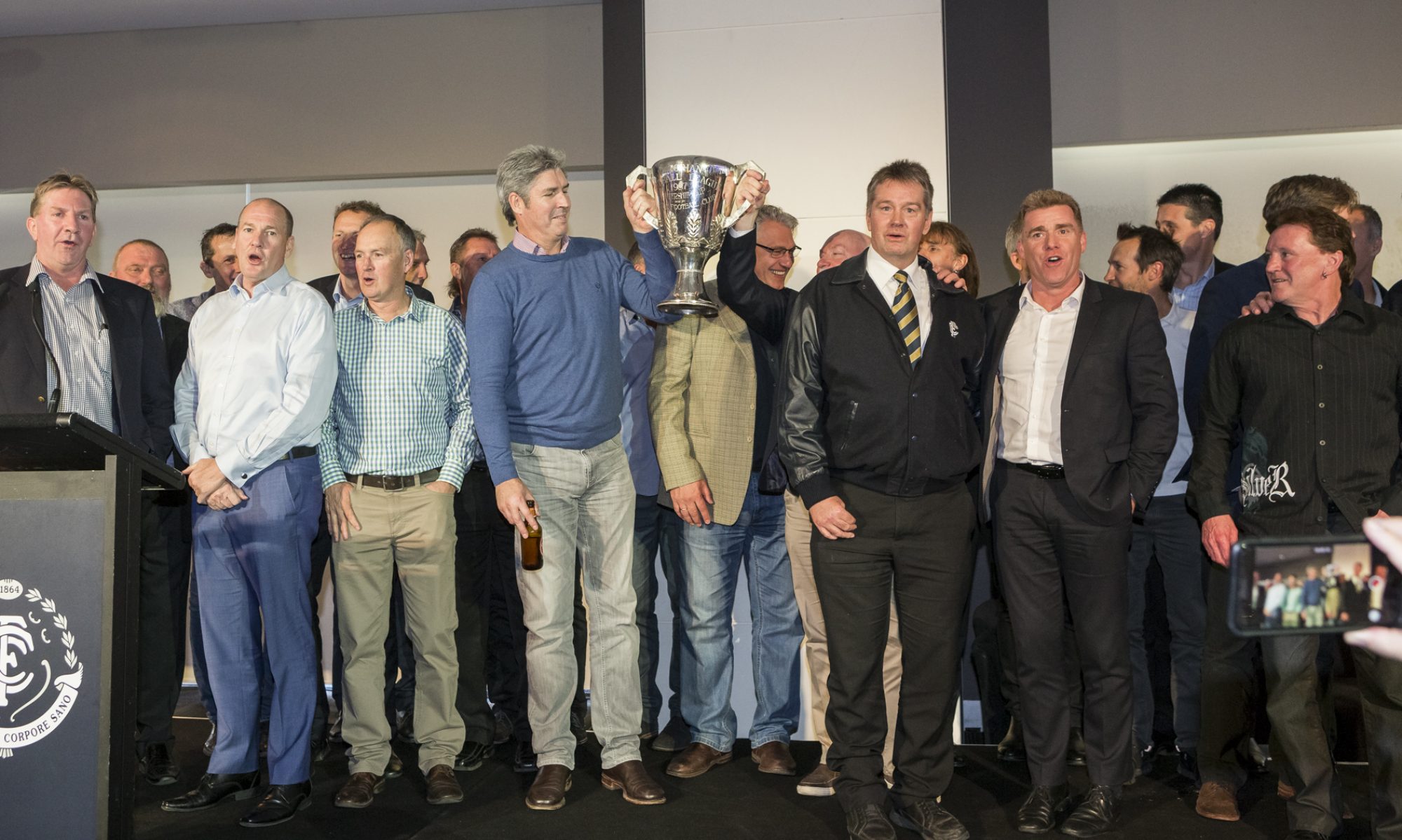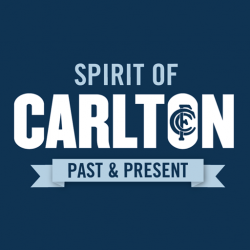Carlton is mourning the loss of dual premiership player, John Goold.
By Tony De Bolfo

THE CARLTON premiership player John Goold – the long-locked, long-striding centre half-back whose overt flamboyance on the football field was more than matched by his glitz and glamor off it – has died after a long illness at the age of 82.
Goold featured in two of the most famous of all Carlton victories – the drought-breaking Grand Final win of 1968 over Essendon, and 1970’s come-from-behind Grand Final conquest of Collingwood, in what was his 108th and final on-field appearance for the Club.
Through the swinging sixties, the sartorially-elegant Goold forged a glorious reputation as football’s first fashionista. A fashion designer away from the game, Carlton’s cravat-collared clothes horse was once depicted by The Age cartoonist Sam Wells in his dark Navy Blue guernsey, shorts, socks and boots – and an accompanying top hat, cane and spats.
Wells dubbed Goold ‘Mr. Debonair’ and Lou Richards went with ‘Mr. Elegant’ – but Goold is forever remembered as ‘Ragsy’ – a moniker given him by his Carlton teammates in homage to his involvement in the rag trade.
Hailing from Healesville in the heart of Victoria’s idyllic Yarra Valley, John William Crosbie Goold was, from the outset, a sportsman of renown. At Melbourne Grammar he excelled at tennis, athletics, football and cricket, but he also developed a penchant for the traditional field pastime of polo and the rough and tumble of fox hunting as an adept horseman.
A fervent Melbourne supporter, Goold somewhat surprisingly lacked a genuine confidence in his footballing ability. “If I thought I was good enough I would certainly have gone to Melbourne,” he said in an interview years later, “but I honestly didn’t think I would ever amount to anything in this game. Cricket and tennis were the games that really interested me”.
After graduating from Grammar, Goold headed home to Healesville, and chased the leather for the Yarra Valley Bloods. In 1962 he featured prominently in their Grand Final victory – which in turn attracted the discerning eye of many a talent scout.
“Incentives were offered elsewhere,” Goold recalled, “but I gravitated to Carlton – partly because the deep blue of their guernsey attracted me, but mostly because of the good advice I got from people who even then were longsighted enough to predict that big things were ahead for this club.”
A little known tale told by the late Ken Hands involved rival club Richmond’s overture to Goold, at a time when the player was still very much a free agent.
“Goold came to training with us at Carlton and had made arrangements to go to another club (Richmond) for dinner that night,” Hands told this reporter some years ago.
“I asked the secretary to leave out a recruiting form for me, but he didn’t do it – he’d already gone home and locked up his office. So I parked my car outside the window of his office, got on the roof of the car and climbed up a water pipe to get in his window to grab the paperwork.
“John (Goold) then signed the form and I made certain it was lodged at Harrison House that night before he met up with the other club.”
Goold himself corroborated Hands’ version of events. “He (Hands) wasn’t a young man at the time, he held down quite a responsible job and here he was climbing up a pipe”.
At Princes Park, Goold was handed the woollen No.11 previously worn by the likes of Rod McGregor and Laurie Kerr, and later by fellow centre half-backs Bruce Doull and (now) Mitch McGovern.
He donned the guernsey for the first time into Round 7 of 1963 – the match with Footscray at the inhospitable Western Oval – having been named on a forward flank alongside two Brownlow Medallists John James and Goold’s fellow Healesville recruit Gordon Collis.
Goold booted a goal on debut in the visitors’ hard-fought eight-point win, but the future rebounding defender would put just two more over the goal umpire’s hat in his eight-season senior Carlton career.
By his own admission, Goold found his feet after Ron Barassi was sensationally appointed Carlton captain-coach – particularly so after Collis’ health issues created a vacancy in the key defensive post in the second half of season ’65.
Goold always believed Barassi’s investiture served as the catalyst for a football cultural revolution, of which he was incredibly fortunate to be a part.
“I think you could say that 1965 was my first year of League football,” Goold said. “That’s the way I felt – that’s the way I reacted to Barassi.”
Goold’s wind-catching ebony mane, juxtaposed with the pristine white anklets and wrist guards, earned him cult status amongst those behind the fence – but it was his hard-running rebounding, take-the-game-on panache that endeared the left-footer to the good football judges more than any aesthetic.
Not surprisingly, Goold was adjudged third behind John Nicholls and Sergio Silvagni in Carlton’s 1965 Best and Fairest count, and backed it up in ’66 with state selection for the Hobart Carnival. In Hobart he was adjudged runner-up to the West Australian Barry Cable in the Tassie Medal for the carnival’s best, and he capped it off with selection on a half-back flank in the coveted All-Australian team.

The premierships of 1968 and 1970 bookended Carlton’s 1969 Grand Final loss – and Goold played under real duress through the ’69 and ’70 September campaigns. In ’69 he laboured through with shin splints, and in ’70 he was only cleared to play on Grand Final morning, having copped a burst blood vessel and serious swelling to the shin after copping a wayward kick in the previous weekend’s prelim.
In the euphoric aftermath of the 1970 Grand Final, Goold was ferried off to hospital for further treatment to the injury. Within the sanitary confines of the ward, he resolved to give the game away.
After changing tack to pursue a career in farming in Victoria’s western district, Goold formed a diversified pastoral company and purchased a magnificent complex called Ballangeich Run at nearby Ellerslie. As his passion for farming and livestock grew, he began breeding top quality polo ponies, represented Australia in international competition, and further built on his already handsome reputation as a Hunt Master of the hounds – hounds he also bred.
As for his footballing prowess, Goold earned the greatest of praise, beginning with John Nicholls no less.
“He was a good player,” said Nicholls, Goold’s captain in the 1968 and ’70 Grand Finals. “He played centre half-back and he played on the best of them, Royce Hart included . . . and he more than held his own with them all.”
Former Carlton President Ian Collins, who with Robert Walls, Wes Lofts, Barry Gill, Kevin Hall and Goold made up the back six on Grand Final day 1968, considered his late teammate as one of a kind.
“They broke the mould with ‘Ragsy’. He was unique. He was flamboyant, he had flair and he was ‘Mr Elegant’ on and off the field,” said Collins, who shared in the experiences of 75 senior Carlton matches with Goold.
“I was at Carlton before ‘Ragsy’ and it took him a while to break into the seniors, but he was great company from the outset. I used to board at ‘Vonny’ Curtin’s place at 19 Berry Street, Coburg with Maurie Sankey, Gordon Collis and John Reilly, and John Goold and Wes Lofts always lobbed on Sunday nights for dinner. ‘Vonny’ used to cook for us and she called us her boys.”
Collins recalled that Goold and Collis, with the support of a well-heeled club sponsor, pursued an off-field venture in nylon stocking sales – thereby introducing Goold to the clothing industry.
“‘Ragsy’ then went into business with a Jewish woman who took him under her wing, and he started producing his own range of lingerie. That’s when Lou dubbed him ‘Mr Elegant’,” Collins said.
“As a teammate he was fantastic. I loved ‘Gooldy’ as a footballer because he could always do the extraordinary. He stood around 6’2” in the old measurement, he was scrawny like Michael Tuck at Hawthorn, and he could play on the big blokes and the small blokes.
“He was loyal to a fault and I think he liked me because I always tried to protect him.”
Three years ago, Collins and Nicholls were part of a troupe of football club identities – amongst them Carlton premiership players Ken Hunter and Mark Maclure – who completed a three-hour bus trip to Goold’s rural property to celebrate his 80th birthday.
Nicholls said that those in attendance truly savoured the moment with their extravagant host, as together they reminisced about the golden years of Barassi and spoke with great optimism of today’s Carlton under Voss.
“It was a great catch-up. We talked about old days and the culture of Carlton, and I talked about how positive I am with things at the Club now looking up,” Nicholls said.
Until the end, Goold kept a fervent interest in his football club’s fortunes and those of its on-field custodians of today. As Collins said: “He wanted Carlton to succeed in the extreme, and he called a spade a spade”.
An address delivered by Goold to the players at a 2008 Spirit Of Carlton event truly reflected his genuine empathy for his football club – and the message he imparted to the players on that occasion could so easily apply to today’s participants, in keeping with Michael Voss’s “play your role” edict.
“The environments, social values, ambitions and outcomes of a football club can be easily explained by drawing on the simple analogy of a wheel – and the fundamental importance of the axle to the structural impact it has on the pure performance of the wheel to move forward,” Goold said at the time.
“All 22 spokes are attached to the axle and are in turn attached to the wheel’s circumference. If one of the 22 spokes does not perform, the wheel will immediately wobble and fail.
“Players. Look upon yourselves as a single spoke. With a small singular drop in attitude by one spoke the wheel will immediately start to wobble and games are lost.”
John Goold was the 754th player to represent the Carlton Football Club at senior League level. He was awarded Life Membership of the Club in 1970 and inducted into the Hall of Fame in 2011.
He is survived by his partner Deborah and sons Ed and Jock.
The Carlton senior players will wear black armbands into Sunday night’s match with Essendon at the MCG as a mark of respect to the late John Goold.

